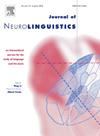Who is ziji or ta-ziji ? An ERP study on the processing mechanism of Chinese bare and compound reflexives
IF 1.2
3区 心理学
Q2 LINGUISTICS
引用次数: 0
Abstract
Previous studies have shown that the constructed representations in online comprehension process are content-addressable, allowing the parser to retrieve dependencies between non-adjacent linguistic elements, such as reflexives and their antecedents, with syntactic and semantic cues serving as retrieval tools operating at distinct temporal stages. However, current research has not effectively addressed the retrieval patterns of Chinese ziji and ta-ziji in the binding of antecedents. This study employed event-related potentials (ERPs) to explore the roles of syntactic cues and animacy cues in the retrieval processes of ziji and ta-ziji using the sentence structure “P-NP1+VP1+P-NP2+ADV+VP2+ziji/ta-ziji+VP3+ADV+VP4+NP.” By constructing where reflexives could reference NP1, NP2, or both, the study examined cue effects. The results showed that ta-ziji elicited P300 and P600 effects when referencing out-of-domain antecedent NP1, reflecting the dominant role of syntactic cues in processing. In contrast, ziji did not produce significant electrophysiological responses but instead elicited P300 and P600 components when it could refer to both NP1 and NP2, indicating that animacy cues can guide the retrieval of ziji alongside syntactic cues during processing. These results suggest that the locality effect of ta-ziji is greater than that of ziji, with the former favoring the structure-favoring cue-based retrieval model, while the latter aligns with the standard cue-based retrieval model.
谁是ziji或ta-ziji ?汉语单反和复合自反加工机制的ERP研究
先前的研究表明,在线理解过程中构建的表征是内容可寻址的,允许解析器检索非相邻语言元素之间的依赖关系,如反思性及其先行词,以句法和语义线索作为检索工具,在不同的时间阶段运行。然而,目前的研究还没有有效地解决汉语子词和塔子词在前词结合中的检索模式。本研究以“P-NP1+VP1+P-NP2+ADV+VP2+子鸡/ta-子鸡+VP3+ADV+VP4+NP”为句式,运用事件相关电位(ERPs)分析句法线索和动画线索在子鸡和ta-子鸡检索过程中的作用。通过构建反身词可以引用NP1、NP2或两者的地方,研究检验了线索效应。结果表明,当参照域外前件NP1时,“打子鸡”诱发了P300和P600效应,反映了句法线索在加工中的主导作用。而当子集同时指向NP1和NP2时,没有产生明显的电生理反应,反而诱发了P300和P600成分,说明在加工过程中,动画提示和句法提示可以共同引导子集的提取。这些结果表明,“塔子集”的局部性效应大于“子集”,前者更倾向于基于结构的线索检索模型,而后者更倾向于基于标准线索的检索模型。
本文章由计算机程序翻译,如有差异,请以英文原文为准。
求助全文
约1分钟内获得全文
求助全文
来源期刊

Journal of Neurolinguistics
医学-神经科学
CiteScore
3.90
自引率
5.00%
发文量
49
审稿时长
17.2 weeks
期刊介绍:
The Journal of Neurolinguistics is an international forum for the integration of the neurosciences and language sciences. JNL provides for rapid publication of novel, peer-reviewed research into the interaction between language, communication and brain processes. The focus is on rigorous studies of an empirical or theoretical nature and which make an original contribution to our knowledge about the involvement of the nervous system in communication and its breakdowns. Contributions from neurology, communication disorders, linguistics, neuropsychology and cognitive science in general are welcome. Published articles will typically address issues relating some aspect of language or speech function to its neurological substrates with clear theoretical import. Interdisciplinary work on any aspect of the biological foundations of language and its disorders resulting from brain damage is encouraged. Studies of normal subjects, with clear reference to brain functions, are appropriate. Group-studies on well defined samples and case studies with well documented lesion or nervous system dysfunction are acceptable. The journal is open to empirical reports and review articles. Special issues on aspects of the relation between language and the structure and function of the nervous system are also welcome.
 求助内容:
求助内容: 应助结果提醒方式:
应助结果提醒方式:


